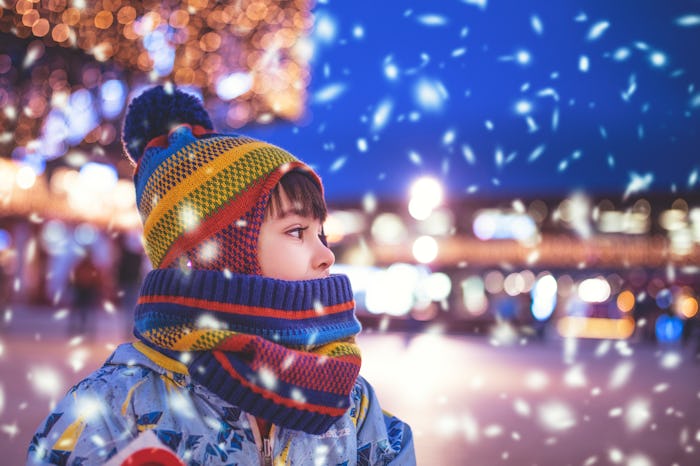Life

7 Winter Solstice Traditions From Around The World To Inspire Your Own Celebrations
As if the month of December didn't have enough celebrations jam-packed into its 31 days, celebrating the day of the year with the least amount of sunlight is also part of the December agenda. Winter Solstice traditions vary across different cultures, but the main idea is to celebrate the longest night of the year with festive activities that embrace the first official day of winter.
The Winter Solstice for the Northern Hemisphere will occur on Friday, Dec. 21 at approximately 11:19 p.m. EST, according to Farmer's Almanac. Up until Dec. 21, our days appear to grow shorter and shorter due to the Earth's angle away from the sun during this time. After Dec. 21, this scenario will switch and our days will appear to be longer and longer until the Summer Solstice (or, the longest day of the year) is reached. Basically, celebrating Winter Solstice means celebrating the fact that longer days and sunshine are headed our way — even if it is months from now.
It's important to note that while those of us on this side of the equator will be celebrating the Winter Solstice, the opposite side of the globe will simultaneously celebrate their Summer Solstice. I, for one, am pretty envious of their ability to bask in the sun while I'm bundled up from head to toe. Nonetheless, Winter Solstice celebrations can be fun, and some ancient traditions have shaped how we celebrate modern holidays. If you're interested in celebrating with your family, these seven traditions may inspire you.
1St. Lucia Day — Scandinavia
In Scandinavia, the Winter Solstice is celebrated on Dec. 13, the day on an ancient calendar once reserved for the Winter Solstice, with St. Lucia Day celebrations, according to Reader's Digest. The Swedish Institute's website described St. Lucia Day festivities as a time when parents gather to watch their children sing traditional songs while dressed in white robes with red sashes, wearing wreaths of candles (or battery-powered lights now in modern times) in a dimly-lit room. This beautiful display is followed by the consumption of gingersnaps, saffron-flavored buns, and a Swedish mulled wine.
This reminds me so much of a children's choir performance at the Christmas service of a church here in the U.S. and sounds like a purely gorgeous way to celebrate Winter Solstice. Now, if only I could get American churches to serve some Swedish mulled wine, I'd be set.
2Stonehenge Gathering — England
The stones at Stonehenge were shaped by ancient architects in such a way that they frame the sunrise of the Winter Solstice, as well as the Summer Solstice, according to a report from the website English Heritage. This historical significance of the ruins has encouraged modern citizens to gather at the site to celebrate the Winter Solstice each year with a large festival held free of charge to all who wish to attend.
3Alban Arthan — Celtic
The ancient Druid tradition of Alban Arthan is a celebration of the Winter Solstice meaning "Light of Winter," per Farmer's Almanac. Thought to be a time of rebirth when old souls are renewed, the longest night of the year is said to be a time when the "old sun" dies and the "new sun" is born in order to revive the Earth's aura. Legend goes that the Druid people would gather under a mistletoe tree and the chief among them would chop mistletoe from the tree and cast it out into the crowd. This tradition is speculated to be part of why we traditionally use mistletoe to decorate and celebrate Christmas today.
4Dong Zhi — China
In China, families gather together for a large feast to celebrate the Winter Solstice during Dong Zhi, according to Reader's Digest. Traditionally, the celebration lasts three days and rice balls called tang yuan are served. As Your Chinese Astrology noted, the Chinese concept of Yin and Yang contributed to the development of Dong Zhi celebrations because ancient people believed that the Winter Solstice marked the beginning of more Yang, or positive occurrences, happening.
5Shab-e Yalda — Iran
In Iran, the Winter Solstice is celebrated with a gathering that lasts the entire night long, Reader's Digest reported. Families gather to feast on fruits and nuts — traditionally watermelon and pomegranate are staples because eating summer fruits in the winter is said to keep illness at bay. Candles, fires, and poetry readings help families stay up all night to celebrate the end of shorter days.
6Lantern Festival — Vancouver
In Vancouver, the Secret Lantern Society celebrates the many cultural traditions of Winter Solstice all over the world with a lantern festival, according to the society's website. Workshops are held for participants to learn the art of lantern-making and a march through the city is held, culminating in a large festival that includes fire performances. A maze of more than 600 candles that visitors can walk through at the celebration is said to symbolize letting go of old thoughts and embracing new possibilities in the new year, according to Reader's Digest.
7Toji — Japan
During Toji, the Winter Solstice is celebrated in Japan by consuming traditional winter squash called kabocha, as that was once one of the only crops available during this time of year, according to Reader's Digest. Additionally, hot citrus baths are taken in order to soothe dry winter skin, refresh the spirit, and keep illnesses away during Toji, National Geographic reported. That sounds like an incredibly relaxing way to ring in the Winter Solstice and a tradition that I can 100% get behind starting in my own household.
This article was originally published on